In late 1943 the 2nd Marine division was only equipped with M3 Stuart light tanks. To give the Marines an extra punch a unit of of M4A2 Sherman tanks was attached to the invasion forces bound for Tarawa. This unit was C Company, 1st Corps Tank Battalion (medium).
The 1st Corps Tank Battalion (medium) was a relatively new Marine unit by November 1943. The table of organization called for a strength of 29 officers (one Navy), 8 warrent officers, and 667 enlisted (13 Navy). The battalion's armor consisted of four M4A2 Sherman tank companies. Each compay had 3 platoons with four tanks and a headquarters platoon with two tanks. The battalion was activated at Camp Elliott, California on 18 January 43. In July the unit moved to Noumea, New Caledonia, which seved as it's base of operations. By mid November 1943 C Company was aboard the USS Ashland steaming toward their first amphibious landing on Betio.
The idea behind the creation of 1st Corps Tank Battalion was to provide tank companies for attachment to divisional light tank battalions to augment a Marine divisions light tanks. C Company was attached to the 2nd Marine Division's 2nd Light Tank Battalion for the Tarawa invasion.
The Battalion was inactivated on 15 February 1944 at Noumea and its companies were reassigned to divisional tank battalions. 1
|
||||||||||||||||||||||||
This table shows the order of battle for the C Co. Shermans on Betio.
If some of the blank names are known please email the information. 2Fourteen Shermans from C Company started out from the line of departure. Eight tanks were to land on Red Beach 3 under command of 1st Lt. Lou Largey. The other six were to proceed to Red Beach 1 with 1st Lt. Ed Bale in the lead. While heading for the reef, two LCMs were sunk along with their Sherman tank cargo. The 12 remaining tanks made it onto the reef and began rolling toward the beach. Two of these Shermans never made it to the beach because they sank in deep shell holes. According to Alexander most of the crew from one tank drowned riding low in tight quarters. C Co. and in fact all Marine Shermans at this time had no water fording kits available. This meant these Shermans were unable to operate in depths greater than three feet. Field expedient sheet metal stack extentions were fabricated but were of no use in a deep shell crater which were many on the reef ringing Betio. In any case ten Sherman tanks touched down on Betio's beach.3
On Red 3, the four tanks of 3rd Platoon Cannonball, Colorado, Charlie,and Condor , had made it to the beach. This unit landed on Red Beach 3 intact, except for Colorado which had taken a sharp hit on the front hull from a medium caliber Japanese gun. Their orders were to advance and blast any bunkers encountered. In a very short time three of the Shermans were put out of action. The exception was Colorado. After being hit a second time by another Japanese gun and bursting into flames the tank was driven straight back to the water on Red Beach 3. Dented and charred, Colorado was saved. It was the only Sherman to survive the first day on Red Beach 3.
The three other tanks of C Company had all been put of action very quickly including Largey's own mount, Cannonball. The four tanks had proceeded through a hole blasted in the Red 3 seawall and proceded inland in an attempt to gain the southern shore of Betio. Cannonball and Charlie had crossed the taxiway and were headed through the triangle area in the central portion of the island. Largey in Cannonball had become mired in a burning fuel dump while Charlie had been hit by a 47mm Japanese gun and set on fire.
The 2nd platoon rolled onto Red Beach 3 and quickly reformed there before a short drive over to Red 2.
The tanks of the 1st Platoon and Company HQ, led by First Lt. Ed Bale, had orders to land on Red Beach 1. After the LCM's dropped their ramps on the edge of the reef the tanks began lumbering forward toward the western most landing beach. Only four Shermans, China Gal, Chicago, Cobra, and Cecilia made it onto the island from this group. Chicago reportedly stalled out in a deep shell hole while manuvering near the island. (note - no confirmation of this)
More on the way....
All but one Sherman was recovered after the fighting. They were sent back to Hawaii for refitting and later reissued to another unit that used them in the Marshall Islands campaign in early 1944.

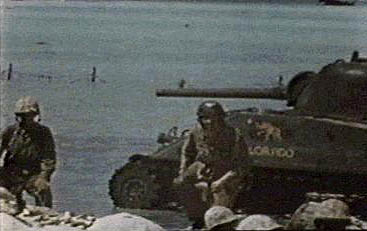 After
being hit by a Japanese gun and set on fire, Colorado was driven back to
Red Beach 3 to douse the flames. Above, one of the crew exits Colorado.
Below and left show Colorado on Red Beach 3 during D-Day. Notice the different
water levels in the three pictures. Evidently the tank was parked on Red
3 for some time.
After
being hit by a Japanese gun and set on fire, Colorado was driven back to
Red Beach 3 to douse the flames. Above, one of the crew exits Colorado.
Below and left show Colorado on Red Beach 3 during D-Day. Notice the different
water levels in the three pictures. Evidently the tank was parked on Red
3 for some time.

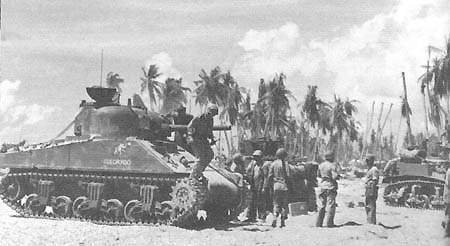
Here again is the indomitable tank, "Colorado" with two Stuarts in the background. These Marines appear to be unconcerned about Japanese snipers. This picture was probably taken before the last push down the "tail" of the island.
The elephant insignia is clearly visible.
Click here to zoom in on "Colorado".

Chicago is shown above knocked out.
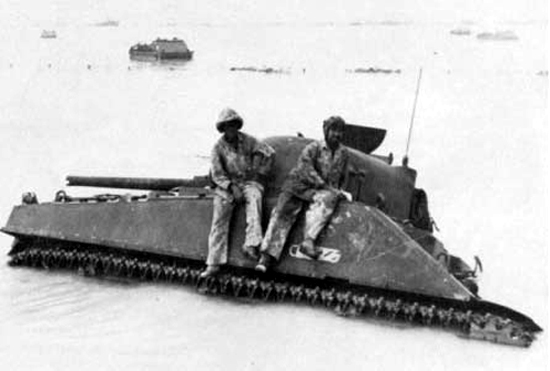
This is another drowned out tank, Cobra, located
on Red Beach 1.
Shown below is the same tank from another angle.
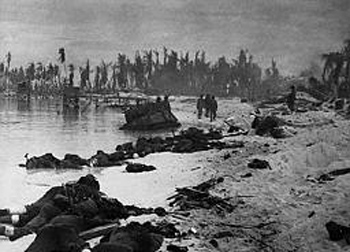

"Condor" was reportedly disabled by a Navy divebomber.

"Cannonball" was driven into a burning fuel dump and
put out of action.
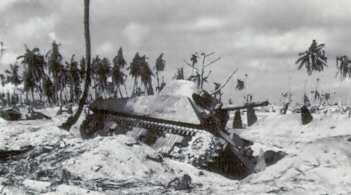
Another view of Cannonball. For more information click
here.
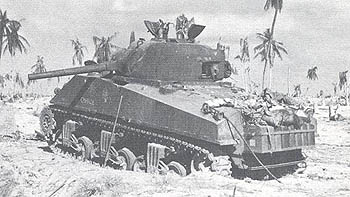
Another tank of C Company, "Charlie,"
was probably hit by a Japanese 47mm gun..

Some damage done to Commando from Japanese heavy machine
guns and AA weapons.
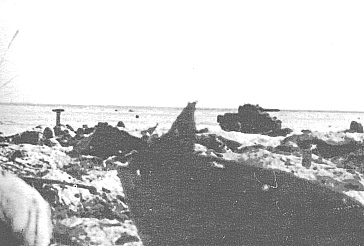
An unidentified Sherman advancing along one of the beaches.
M3 Stuart Tanks of the 2nd Tank Battalion, 2nd Division

This tank probably just left a landing craft and is headed
for Betio.
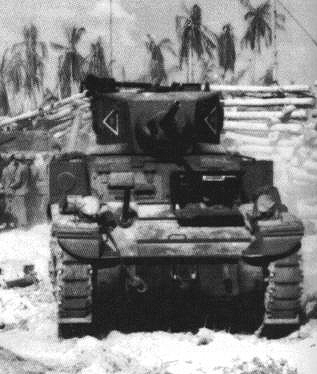
These Stuart tanks are parked behind the cover of the
aircraft revetments.
They are probably forming up for an attack.


One of the tanks from B Company, 2nd Tank Battalion tows
a 37mm AT gun
from Weapons Co, 6th Marines to the 1st battalion 6th Marines on D+2. 4
End Notes
1. Gordon Rottman, email 24 May 1999, from WWII-l@listserv.acsu.buffalo.edu
2. Information compiled by George Proul.
3. Alexander, p.126.
4. Hammel, Bloody Tarawa, p.214-215.
Related Links
What happened to C Company on Betio?
"MORE AMMMO!" Pack howitzer ammo in a Sherman?
Link to the Marine Corps Tanker Association
Send an Email
copyright 2000-3 T.O.T.W.
Created 18 March 2000 - Updated 18 April 2003
